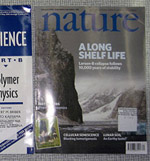Ocean rigs as vectors for entire communities of invasive species
We present two studies today evaluating boats as unintentional transporters for invasive species. One study offers good news, the other bad. We start with the bad...
Scientists have long recognized marine transport as a vector for exotic species invasions. But relatively little attention has been given to the transport of semi-submersible rigs - the installations that are used for oil drilling.
A case study from the remote island of Tristan de Cunha of the South Atlantic shows that when these rigs are being hauled, they can carry virtually intact reef communities with them from one place to another. This is what happened when a decommissioned rig being transported from Brazil to Singapore had to be abandoned at sea. Fisherman from the Tristan de Cunha found the structure washed up on the island.
Ross Wanless and fellow scientists conducted an inventory and risk analysis of the species transported with the rig. Tristan de Cunha like other remote islands contains many endemic species and its ecological characteristics make it particularly at risk to exotic species invasions. Invasive species and pathogens they might carry could threaten the island's main source of income - fishing for the Tristan rock lobster (Jasus tristani).
The scientists identified at total of 62 non-native taxa including corals, barnacles, sponges, crustaceans, and the first records of free-swimming marine finfish populations becoming established after unintentional movement. They also searched for terrestrial organisms - the rig had dormitories and a kitchen with half-eaten plates of food left out - and found live insects but no rodents.
Ultimately the rig was salvaged and disposed at a cost of $20 million. Most frustrating is that this problem could have been avoided at much less cost to the insurance company that had to food the bill. The authors write,
"It is recommended that as a basic precaution to prevent (or minimise) the spread of invasive alien species associated with the movement of rigs encrusting/biofouling organisms should be physically removed or otherwise killed (e.g. by prolonged immersion in freshwater or exposure to air) immediately prior to towing…This should be made standard practice for all pretowing contracts and, given the extreme expenses demonstrated by this study, we expect that the maritime insurance industry should become proactive in regulating this."
--Reviewed by Rob Goldstein
Wanless, R., Scott, S., Sauer, W., Andrew, T., Glass, J., Godfrey, B., Griffiths, C., & Yeld, E. (2009). Semi-submersible rigs: a vector transporting entire marine communities around the world Biological Invasions DOI: 10.1007/s10530-009-9666-2




 Invasive
Invasive
Reader Comments